MITSUBISHI LANCER 2016 8.G Owner's Guide
Manufacturer: MITSUBISHI, Model Year: 2016, Model line: LANCER, Model: MITSUBISHI LANCER 2016 8.GPages: 392, PDF Size: 13.12 MB
Page 31 of 392
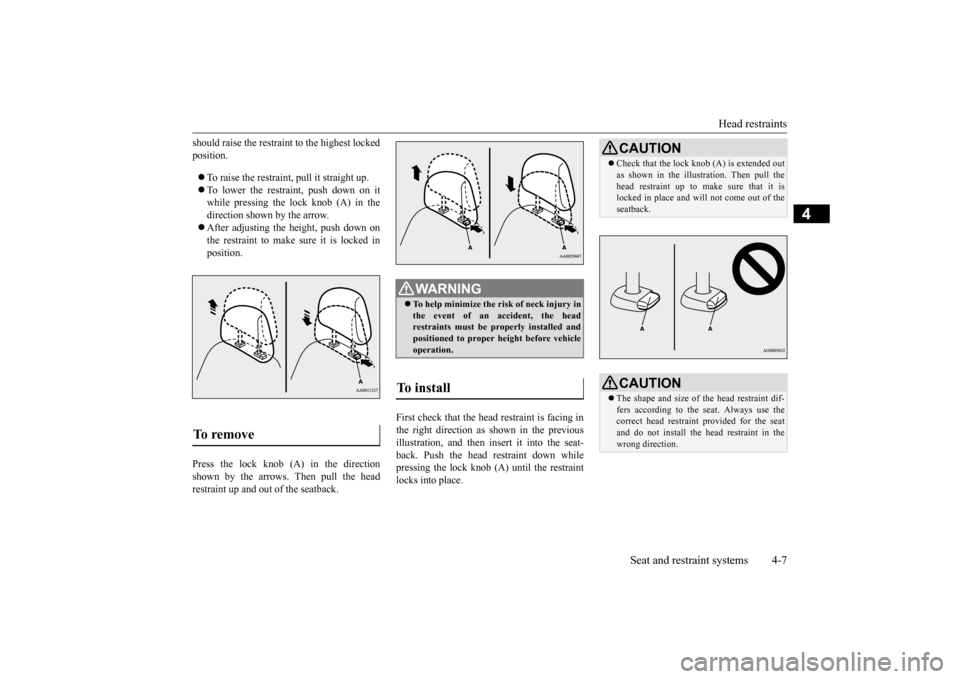
Head
restraints
Seat and restraint systems
4-7
4
should
raise
the
restraint
to the
highest
locked
positi
on.
To raise the restraint, pull it straight up.
To lower
the
restraint,
push
down
on
it
while
pressing
the
lock
knob
(A)
in
the
direction
shown
by
the
arrow
.
After
adjusting
the
height,
push
down
on
the
restraint
to
make
sure
it is locked
in
position.
Press
the
lock
knob
(A)
in
the
direction
shown
by
the
arrows.
Then
pull
the
head
restraint up and out of the seatback.
First
check
that
the
head
restraint
is facing
in
the
right
direction
as
shown
in
the
previous
illustration,
and
then
insert
it into
the
seat-
back.
Push
the
head
restraint
down
while
pressing
the
lock
knob
(A)
until
the
restraint
locks into place.
To r
emove
W
AR
NING
To help
min
imize
the risk
of neck
injury in
the even
t of
an accid
ent,
the head
restraints
must
be
properly
installed
and
positione
d to proper
height
befor
e vehicle
operat
ion.
To install
CAUTIONCheck
that
the
lock
knob
(A)
is extended
out
as
shown
in
the
illustration.
Then
pull
the
head
restraint
up
to
make
sure
that
it is
locked
in place
and
will
not
come
out
of the
seatback.CAUTIONThe
shape
and
size
of the
head
restraint
dif-
fers accordi
ng
to
the seat.
Always
use
the
correct
head
restrain
t pro
vided for
the
seat
and
do
not
install
the
head
restraint
in the
wrong
direction.
Page 32 of 392
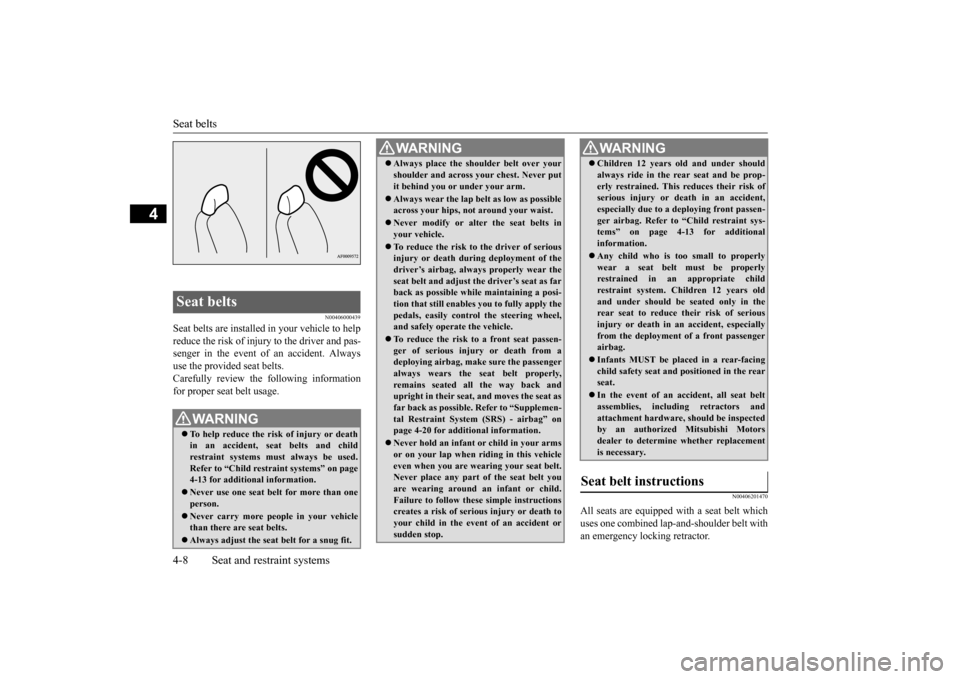
Seat
belts
4-8
Seat and restraint systems
4
N0040600
0439
Seat
belts
are
installed
in your
vehicle
to help
reduce
the
risk
of injury
to the
driver
and
pas-
senger
in
the
event
of
an
accident.
Always
use the provided seat belts. Carefully
review
the
following
information
for proper seat belt usage.
N0040620
1470
All
seats
are
equipped
with
a seat
belt
which
uses
one
combined
lap-and-shoulder
belt
with
an emer
gency locking retractor
.
Seat belts
W
AR
NING
To help
reduce
the
risk
of injur
y or death
in an accid
ent,
seat
belts
and
child
restrain
t systems
must
alw
ays
be use
d.
Refer
to “Child
restraint
systems”
on
page
4-13 for
addi
tional
infor
mati
on.
Never use
one
seat belt for
mor
e than
one
person. Never
carry
mor
e people
in
your
vehicle
tha
n the
re are seat belts.
Always adjust the seat
belt for a snug
fit.
Alway
s place
the
shoul
der
belt over
your
shoulder
and
acr
oss your
chest.
Never
put
it behind
you
or under
your
arm.
Always
wear
the
lap
belt
as low
as possible
acr
oss your
hips,
not
around
your
waist.
Never
modi
fy
or
alter
the
seat
belts
in
your
vehicle.
To reduce
the risk
to the driver
of seriou
s
injury
or
death
durin
g deploymen
t of the
driver
’s airb
ag,
alw
ays
properly
wear
the
seat belt and
adjust
the
driv
er’s seat as far
bac
k as possi
ble while
mai
ntai
ning
a posi
-
tion
that
still
enables
you
to fully
appl
y the
pedals,
easily
contr
ol
the
steering
wheel,
and safely
operate
the
veh
icle.
To reduce
the
risk
to a front
seat passe
n-
ger
of serious
injury
or death
from a
deployi
ng airb
ag,
make
sur
e the
passenge
r
alw
ays
wears
the
seat
belt properly
,
remai
ns
seate
d all
the
way
bac
k and
upright
in their
seat,
and
moves
the
seat
as
far
bac
k as possi
ble. Refer to “Supplem
en-
tal
Restraint
System
(SRS)
- airbag”
on
page
4-20
for
addi
tional infor
mati
on.
Never
hold
an
infant
or child
in your
arms
or
on
your lap
whe
n rid
ing in this vehicle
even
whe
n you are wearin
g your seat belt.
Never
place
any par
t of the
seat
belt you
are wearing
around
an
infant
or
child.
Failur
e to follow
these
simple
instructions
create
s a risk
of serious
injury
or death
to
your
child
in the
event
of an
accident
or
sudden
stop.
W
AR
NING
Child
ren 12
years old and
under
shoul
d
always
rid
e in the
rear seat and
be prop-
erly
restrained. Thi
s reduces
their
risk
of
serious
injur
y or death
in an
accid
ent,
especia
lly due
to a deployi
ng
front
passe
n-
ger
airbag.
Refer
to “Child
restraint
sys-
tems”
on
page
4-13
for
addi
tional
infor
mati
on.
Any
child who
is too
small
to
properly
wear
a seat
belt must
be properly
restrained in an
appr
opriat
e child
restraint
syste
m.
Child
ren 12
yea
rs old
and
under
should
be
seated
only
in
the
rear seat
to
reduce
their
risk
of
serious
injur
y or death
in an
accid
ent,
especia
lly
from
the
deployment
of a front
passenger
airbag.Infants
MUST
be placed
in a rear-facin
g
child safe
ty seat and
positione
d in the
rear
seat.In
the
event
of
an
accident,
all
seat
belt
assemblies,
including
retractors
and
attach
men
t hardwa
re, sho
uld be inspected
by
an
authorized
Mitsubi
shi
Motor
s
dealer
to determ
ine whe
ther
replacem
ent
is necessary
.
Seat belt instructions
W
AR
NING
Page 33 of 392
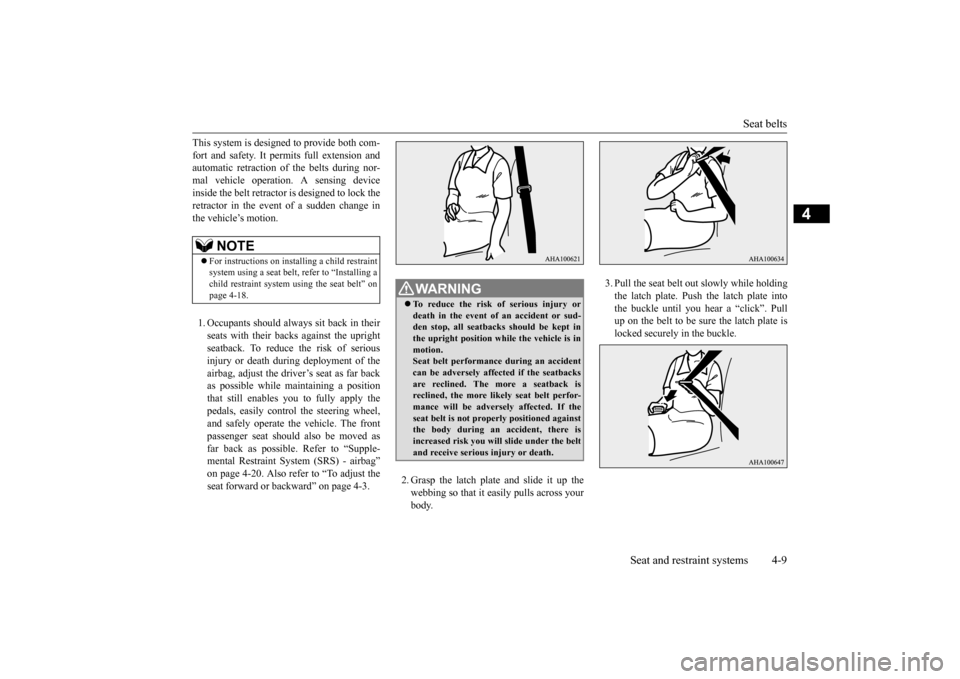
Seat
belts
Seat and restraint systems
4-9
4
This
system
is designed
to provide
both
com-
fort
and
safet
y. It permit
s full
exten
sion
and
automatic
retraction
of
the
belts
during
nor
-
mal
vehicle
operation.
A
sensing
device
inside
the
belt
retractor
is designed
to lock
the
retractor
in
the
event
of
a sudden
change
in
the vehicle
’s motion.
1.Occupants
should
always
sit
back
in their
seats
with
their
backs
against
the
upright
seatback.
To reduce
the
risk
of
serious
injury
or
death
during
deployment
of
the
airbag,
adjust
the
driver
’s seat
as
far
back
as possible
while
maintaining
a pos
ition
that
still
enables
you
to
fully
apply
the
pedals,
easily
control
the
steering
wheel,
and
safely
operate
the
vehicle.
The
front
passenger
seat
should
also
be
moved
as
far
back
as
possible.
Refer
to
“Supple-
mental
Restraint
System
(SRS)
- airbag”
on
page
4-20.
Also
refer
to “To adjust
the
seat forward or backward” on page 4-3.
2.Grasp
the
latch
plate
and
slide
it up
the
webbing
so
that
it easily
pulls
across
your
body
.
3.Pull
the
seat
belt
out
slowly
while
holding
the
latch
plate.
Push
the
latch
plate
into
the
buckle
until
you
hear
a “click”.
Pull
up
on
the
belt
to be
sure
the
latch
plate
is
locked securely in the buckle.
NOTE
For
instructions
on
installing
a child restrain
t
system
using
a seat
belt,
refer
to “Installing
a
child
restraint
system
using
the
seat
belt”
on
page
4-18.
W
AR
NING
To reduce
the
risk
of
serious
injury
or
death
in the
event
of an
accident
or
sud-
den stop,
all
seatbacks
sho
uld be kept
in
the
upright
position
while
the
vehicle
is in
motion.Seat
belt performance
during
an accid
ent
can
be
adversely
affected
if the
seatbacks
are reclined.
The
mor
e a seatback
is
reclined,
the
mor
e likely
seat
belt
perfor
-
mance
will
be
adversely
affected.
If the
seat
belt
is not
properly
positioned
against
the
body durin
g an
accid
ent,
the
re is
increas
ed risk
you
will slide under
the
belt
and
receive s
erious
injur
y or
death.
Page 34 of 392
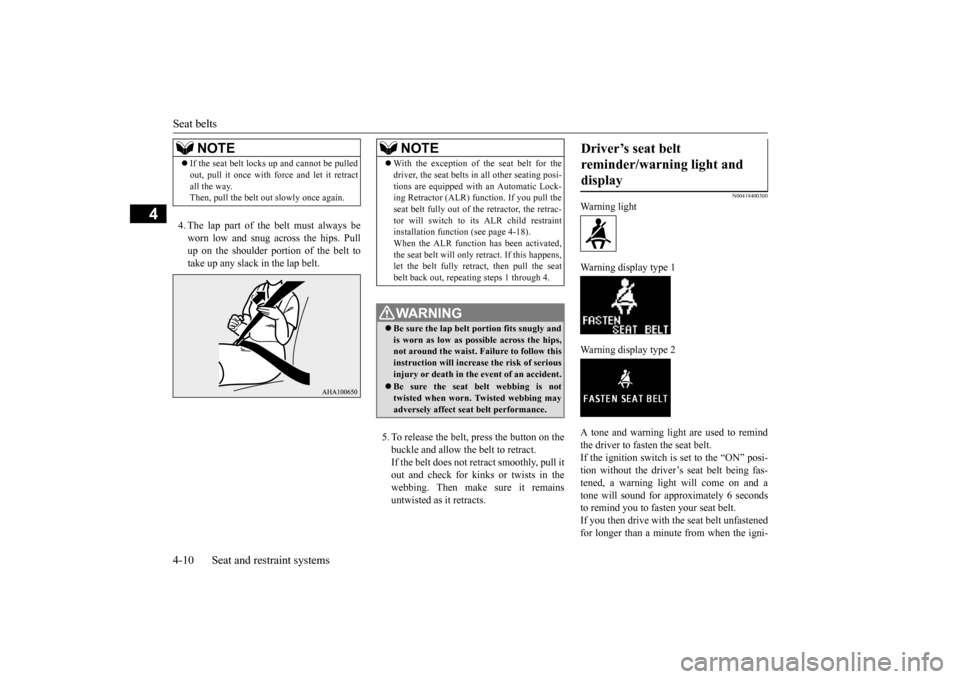
Seat
belts
4-10
Seat and restraint systems
4
4.The
lap
part
of
the
belt
must
always
be
worn
low
and
snug
across
the
hips.
Pull
up
on
the
shoulder
portion
of
the
belt
to
take
up
any
slack
in the
lap
belt.
5.To release
the
belt,
press
the
button
on
the
buckle and allow the belt to retract. If the
belt
does
not
retract
smoothly
, pull
it
out
and
check
for
kinks
or
twists
in
the
webbing.
Then
make
sure
it
remains
untwisted as it retracts.
N0041840
0300
Warning light
Warning display type 1
Warning display type 2
A tone
and
warning
light
are
used
to remind
the driver to fasten the seat belt.If the
ignition
switch
is set
to the
“ON”
posi-
tion
without
the
driver
’s seat
belt
being
fas-
tened,
a warning
light
will
come
on
and
a
tone
will
sound
for
approximately
6 seconds
to remind you to fasten your seat belt.If you
then
drive
with
the
seat
belt
unfastened
for
longer
than
a minute
from
when
the
igni-
NOTE
If the
seat
belt
locks
up
and
cannot
be pulled
out,
pull it once
with force
and
let
it retract
all
the way.
Then, pull
the
belt
out slowl
y once again
.
NOTE
With
the
exception
of
the
seat
belt
for
the
driver
, the
seat
belts
in all
other
seating
posi-
tions
are equi
ppe
d with an Aut
omatic
Lock-
ing
Retractor
(AL
R)
function.
If you
pull
the
seat
belt
fully
out
of the retracto
r, the retrac-
tor
will
switch
to its ALR child restrain
t
installation
function
(see
page
4-18).
When the ALR function
has been
activ
ated
,
the
seat
belt
will
only
retract.
If this
happens,
let
the belt
fully
retract,
then pull
the
seat
belt
back
out,
repeating
steps
1 through
4.
W
AR
NING
Be
sur
e the
lap
belt por
tion
fits snugl
y and
is worn
as low
as pos
sible
acr
oss the
hips,
not around
the waist. Failu
re to follow
this
instru
ction
will increas
e the risk
of seriou
s
injury
or death
in the
event
of an
accident.
Be sur
e the
seat
belt webbi
ng
is not
twisted
when
worn.
Twisted
webbing
may
adversely affect seat belt performance.
Driver
’s seat belt
reminder/warning light and
display
Page 35 of 392
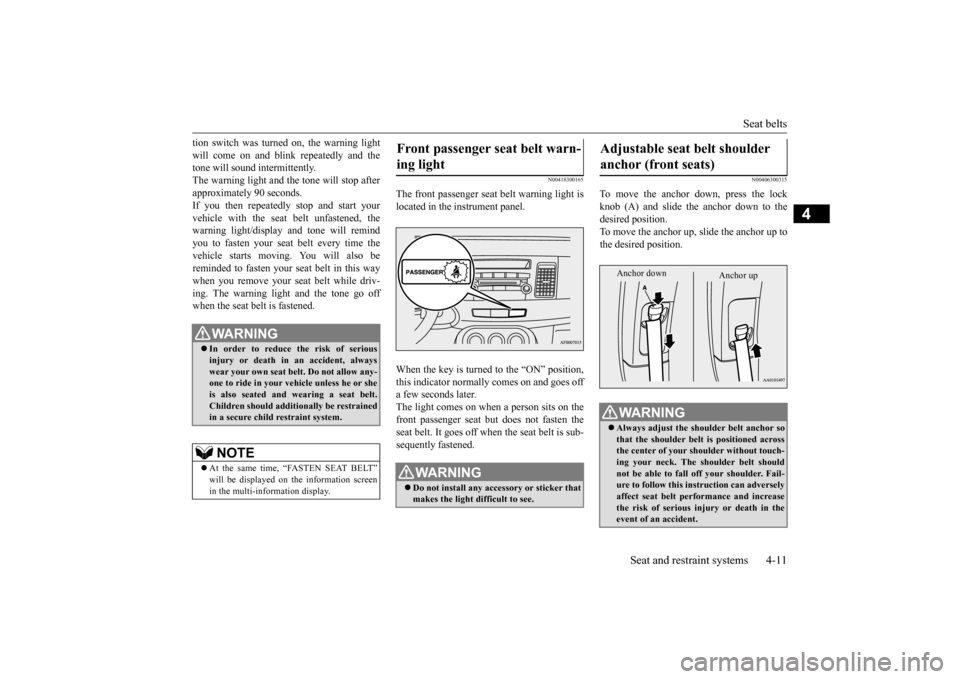
Seat
belts
Seat and restraint systems
4-11
4
tion
switch
was
turned
on,
the
warning
light
will
come
on
and
blink
repeatedly
and
the
tone
will
sound
intermittentl
y.
The
warning
light
and
the
tone
will
stop
after
approximately 90 seconds.If
you
then
repeatedly
stop
and
start
your
vehicle
with
the
seat
belt
unfastened,
the
warning
light/display
and
tone
will
remind
you
to
fasten
your
seat
belt
every
time
the
vehicle
starts
moving.
You
will
also
be
reminded
to fasten
your
seat
belt
in this
way
when
you
remove
your
seat
belt
while
driv-
ing.
The
warning
light
and
the
tone
go
off
when
the
seat
belt
is fastened.
N00418300
165
The
front
passenger
seat
belt
warning
light
is
located in the instrument panel.When
the
key
is turned
to the
“ON”
position,
this
indicator
normally
comes
on
and
goes
off
a few seconds later
.
The
light
comes
on
when
a person
sits
on
the
front
passenger
seat
but
does
not
fasten
the
seat
belt.
It goes
off when
the
seat
belt
is sub-
sequently fastened.
N00406300
315
To move
the
anchor
down,
press
the
lock
knob
(A)
and
slide
the
anchor
down
to
the
desired position. To move
the
anchor
up,
slide
the
anchor
up
to
the desired position.
W
AR
NING
In
order
to
reduce
the
risk
of
serious
injury
or
death
in
an
accident,
always
wear
your own
seat belt. Do
not
allow
any-
one to ride in your vehicle unless he or she is also
seate
d and
wearing
a seat
belt.
Child
ren sho
uld addition
ally
be restrain
ed
in a secu
re child
restraint syste
m.
NOTE
At the same
time,
“FASTEN
SEAT BELT”
will be display
ed on
the information
screen
in the multi-information
display
.
Fr
ont passenger seat belt warn-
ing light
W
AR
NING
Do not install
any accessory
or stick
er that
makes the light difficult to see.
Adjustable seat belt shoulder anchor (fr
ont seats)
W
AR
NING
Always
adjust
the
shoulder
belt
anchor
so
that
the
shoul
der belt is posi
tione
d across
the
center
of your
shoul
der without
touc
h-
ing
your
neck.
The
shoul
der
belt shoul
d
not
be able
to fall
off
your
shoul
der. Fail-
ure to follow
this instr
uction
can
advers
ely
affect
seat belt perfor
mance
and
increase
the
risk
of serious
injur
y or death
in the
event of an accident.Anchor
down
Anchor
up
Page 36 of 392
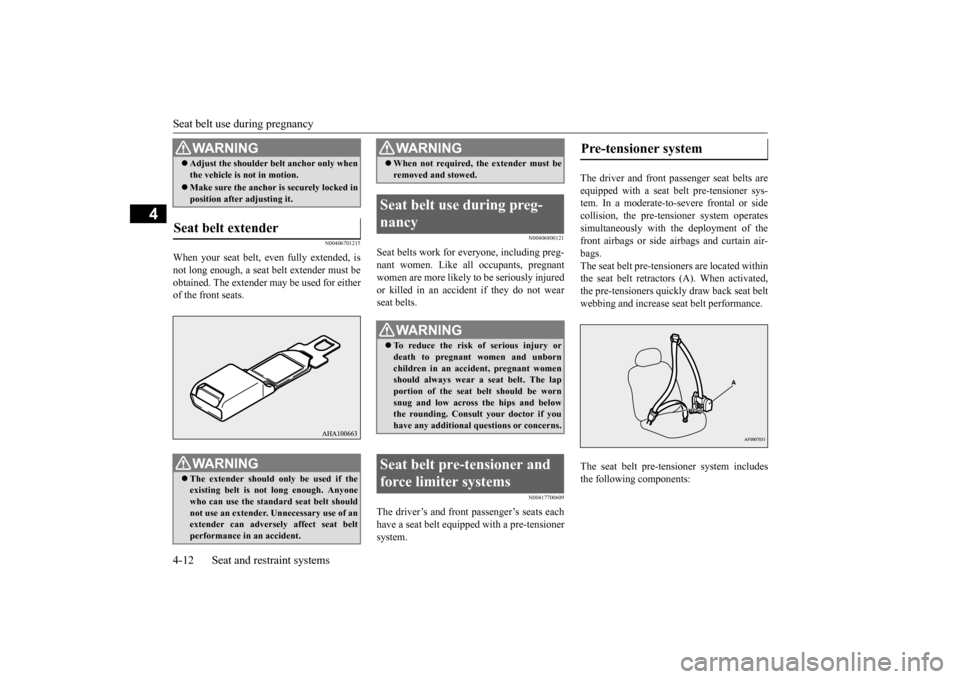
Seat belt use during pregnancy4-12
Seat and restraint systems
4
N0040670
1215
When
your
seat
belt,
even
fully
extended,
is
not
long
enough,
a seat
belt
extender
must
be
obtained.
The
extender
may
be
used
for
either
of the
front
seats.
N0040680
0121
Seat
belts
work
for
everyone,
including
preg-
nant
women.
Like
all
occupants,
pregnant
women
are
more
likely
to be
seriously
injured
or
killed
in
an
accident
if they
do
not
wear
seat
belts.
N0041770
0609
The
driver
’s and
front
passenger
’s seats
each
have a seat belt equipped with a pre-tensioner system.
The
driver
and
front
passenger
seat
belts
are
equipped
with
a seat
belt
pre-tensioner
sys-
tem.
In
a moderate-to-severe
frontal
or
side
collision,
the
pre-tensioner
system
operates
simultaneously
with
the
deployment
of
the
front
airbags
or
side
airbags
and
curtain
air-
bags.The
seat
belt
pre-tensioners
are
located
within
the
seat
belt
retractors
(A).
When
activated,
the
pre-tensioners
quickly
draw
back
seat
belt
webbing and increase seat belt performance. The
seat
belt
pre-tensioner
system
includes
the following components:
Adjust
the
shoulder
belt
anchor
only
when
the
vehicle
is not
in motion.
Mak
e sur
e the anchor is secu
rely
lock
ed in
position
after
adjusting
it.
Seat belt extender
W
AR
NING
The
extender
should
only
be
used
if the
exis
ting belt
is not
lon
g enough. Anyon
e
who
can
use
the
standar
d seat belt shoul
d
not
use
an
exte
nde
r. Unnecessar
y use
of an
exte
nder
can
advers
ely
affect
seat
belt
performance
in an
accident.
W
AR
NING
When not requi
red, the extender
must
be
removed
and
stow
ed.
Seat belt use during pr
eg-
nancy
W
AR
NING
To reduce
the
risk
of
serious
injur
y or
death
to
pregn
ant women
and
unborn
children in an
accid
ent,
pregnant
wome
n
sho
uld alw
ays
wear
a seat
belt.
The lap
por
tion
of
the
seat
belt shoul
d be wor
n
snug
and
low
acr
oss
the
hips
and
below
the
rounding.
Consult
your
doctor
if you
have any
addi
tional
que
stions
or con
cerns.
Seat belt pr
e-tensioner and
for
ce limiter systems W
AR
NING
Pr
e-tensioner system
Page 37 of 392
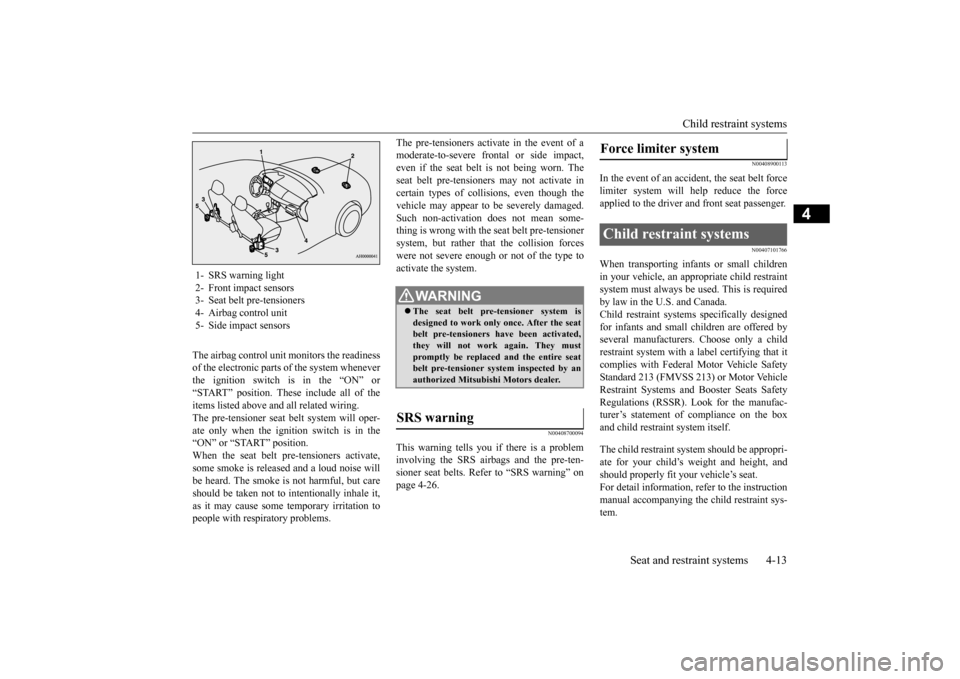
Child restraint systems
Seat and restraint systems
4-13
4
The
airbag
control
unit
monitors
the
readiness
of the
electronic
parts
of the
system
whenever
the
ignition
switch
is
in
the
“ON”
or
“ST
ART” position.
These
include
all
of
the
items listed above and all related wiring. The
pre-tensioner
seat
belt
system
will
oper
-
ate
only
when
the
ignition
switch
is
in
the
“ON”
or “ST
ART” position.
When
the
seat
belt
pre-tensioners
activate,
some
smoke
is released
and
a loud
noise
will
be
heard.
The
smoke
is not
harmful,
but
care
should
be
taken
not
to intentionally
inhale
it,
as
it may
cause
some
temporary
irritation
to
people with respiratory problems.
The
pre-tensioners
activate
in
the
event
of
a
moderate-to-severe
frontal
or
side
impact,
even
if the
seat
belt
is not
being
worn.
The
seat
belt
pre-tensioners
may
not
activate
in
certain
types
of
collisions,
even
though
the
vehi
cle
may
appea
r to be
severely
damaged.
Such
non-activation
does
not
mean
some-
thing
is wrong
with
the
seat
belt
pre-tensioner
system,
but
rather
that
the
collision
forces
were
not
severe
enough
or
not
of
the
type
to
activate the system.
N00408700
094
This
warning
tells
you
if there
is a problem
involving
the
SRS
airbags
and
the
pre-ten-
sioner
seat
belts.
Refer
to “SRS
warning”
on
page 4-26.
N0040890
0113
In the
event
of an
accident,
the
seat
belt
force
limiter
system
will
help
reduce
the
force
applied
to the
driver
and
front
seat
passenger
.
N00407101
766
When
transporting
infants
or
small
children
in your
vehicle,
an
appropriate
child
restraint
system
must
always
be
used.
This
is required
by law in the U.S. and Canada.Child
restraint
systems
specifically
designed
for
infants
and
small
children
are
offered
by
several
manufacturers.
Choose
only
a child
restraint
system
with
a label
certifying
that
it
complies
with
Federal
Motor
Vehicle
Safety
Standard
213
(FMVSS
213)
or Motor
Vehicle
Restraint
Systems
and
Booster
Seats
Safety
Regulations
(RSSR).
Look
for
the
manufac-
turer
’s statement
of
compliance
on
the
box
and child restraint system itself. The
child
restraint
system
should
be
appropri-
ate
for
your
child’
s weight
and
height,
and
should properly fit your vehicle’
s seat.
For
detail
information,
refer
to the
instruction
manual
accompanying
the
child
restraint
sys-
tem.
1-
SRS warning light
2-
Front impact sensors
3-
Seat belt pre-tensioners
4-
Airbag control unit
5-
Side impact sensors
W
AR
NING
The
seat
belt
pre-tensioner
system
is
designe
d to wor
k onl
y once.
After
the
seat
belt pre-tensi
oners
have
been
activate
d,
they
will
not
work
again.
They
must
promptl
y be replaced
and
the
entire seat
belt
pre-tension
er
system
inspected
by an
authorized
Mitsubi
shi
Motors
dealer
.
SRS
warning
For
ce limiter system
Child r
estraint systems
Page 38 of 392
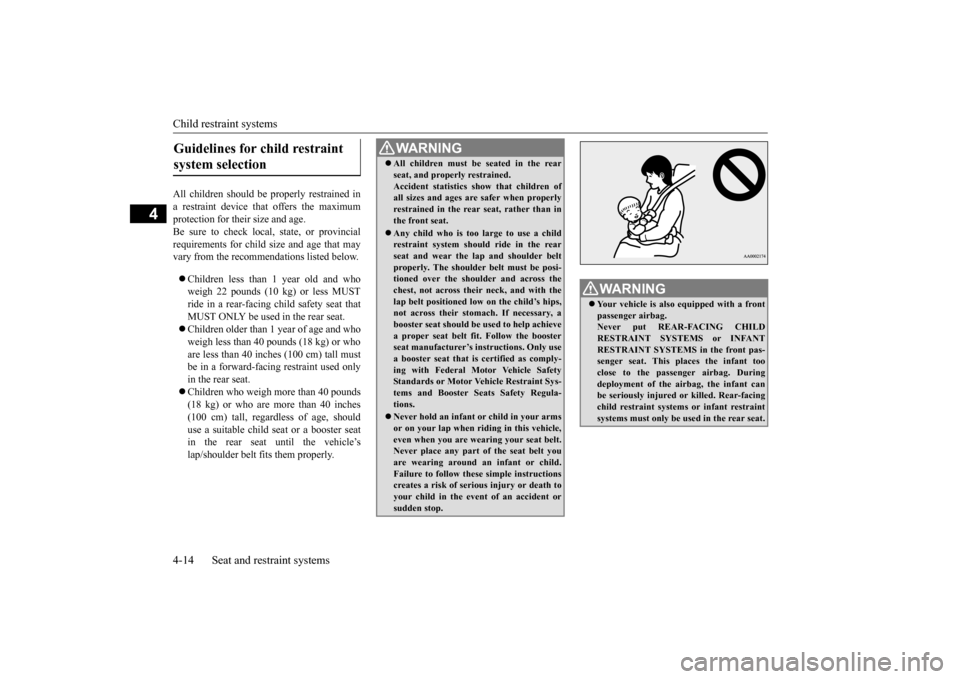
Child
restraint
systems
4-14
Seat and restraint systems
4
All
children
should
be
properly
restrained
in
a restraint
device
that
offers
the
maximum
protection
for
their
size
and
age.
Be
sure
to
check
local,
state,
or
provincial
requirements
for
child
size
and
age
that
may
vary from the recommendations listed below
.
Children
less
than
1 year
old
and
who
weigh
22
pounds
(10
kg)
or
less
MUST
ride
in a rear
-facing
child
safety
seat
that
MUST ONL
Y be used in the rear seat.
Children
older
than
1 year
of age
and
who
weigh
less
than
40
pounds
(18
kg)
or who
are
less
than
40
inches
(100
cm)
tall
must
be
in a forward-facing
restraint
used
only
in the rear seat.Children
who
weigh
more
than
40
pounds
(18
kg)
or
who
are
more
than
40
inches
(100
cm)
tall,
regardless
of
age,
should
use
a suitable
child
seat
or
a booster
seat
in
the
rear
seat
until
the
vehicle’
s
lap/shoulder belt fits them properly
.
Guidelines for child
restraint
system selection
W
AR
NING
All
childr
en must
be
seated
in
the
rear
seat,
and
properly
restrained.
Accident
statistics
show
that
childr
en
of
all
sizes
and
ages
are safer
when
properly
restrained in the
rear
seat, rather
than
in
the
front
seat.
Any
child who
is too
large to use
a child
restraint
system
should
ride
in
the
rear
seat
and
wear
the lap
and
sho
ulder
belt
properly
. The
shoulder
belt
must
be
posi-
tion
ed over
the
shoul
der
and
acr
oss
the
chest,
not
acr
oss their
neck
, and
with
the
lap
belt posi
tione
d low
on
the
child’s hips,
not
acr
oss their
stomach.
If necessary
, a
booster
seat sho
uld be use
d to help
achieve
a proper
seat
belt
fit.
Follow
the
booster
seat
manufac
tur
er’s instr
uctions.
Only use
a booster
seat
that
is certified
as
comply-
ing
with
Federal
Motor
Vehicle
Safety
Standards
or Motor
Vehicle
Restraint
Sys-
tems
and
Booster
Seats
Safety
Regula-
tions. Never
hold
an
infant
or child
in your
arms
or on
your
lap
when
riding
in this
vehicle,
even
whe
n you are wearin
g your seat belt.
Never
place
any par
t of the
seat
belt you
are wearing
around
an
infant
or
child.
Failur
e to follow
these
simple
instructions
create
s a risk
of serious
injury
or death
to
your
child
in the
event
of an
accident
or
sudden
stop.
W
AR
NING
Your vehicle
is also equi
ppe
d with a front
passe
nger
airbag.
Never
put
REAR-
FACING
CHILD
RESTRAINT
SYSTEM
S or INF
ANT
RESTRAINT
SYSTEM
S in the
front
pas-
senger
seat.
Thi
s places
the
infant
too
close
to
the
passe
nger
airbag.
Durin
g
deployme
nt
of
the
airbag,
the
infant
can
be
seriously
injur
ed or
killed.
Rear
-facing
child
restraint
systems
or
infant
restraint
systems
must
only be use
d in the rear
seat.
Page 39 of 392
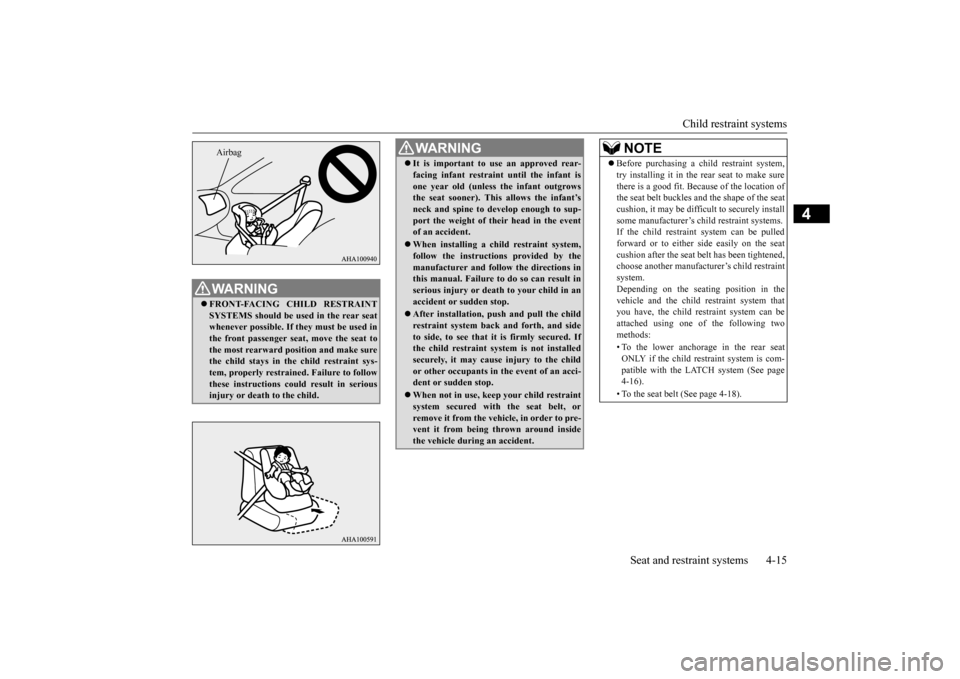
Child restraint systems
Seat and restraint systems
4-15
4
W
AR
NING
FRONT-FACING
CHILD RESTRAINT
SYSTEMS
sho
uld be use
d in the rear
seat
whe
never possi
ble. If the
y must
be use
d in
the front passenger
seat,
move
the seat
to
the
most
rearward
position
and
make
sur
e
the child stays
in the child restrain
t sys-
tem,
properly
restrained. Failure to follo
w
these
instructions
could
result
in
serious
injury
or d
eath to the
child.
Airbag
W
AR
NING
It is imp
ortan
t to
use
an appr
oved
rear
-
facing
infant
restraint
until
the
infant
is
one year
old
(unless
the infan
t outgr
ows
the seat
soon
er).
This allows
the infan
t’s
neck
and
spi
ne to develop
enough to sup-
por
t the
weight
of their
head
in the
event
of an
accid
ent.
Whe
n installing
a child restraint
syste
m,
follow
the
instr
uctions
provi
ded by
the
manufac
tur
er and
follow
the
directions
in
this manual
. Failure to do
so can
resul
t in
serious
injury or death
to you
r child in an
accid
ent or sudde
n stop
.
After
installat
ion,
push
and
pull
the
child
restraint
system
back
and
forth,
and
side
to side,
to see
that
it is firmly
secur
ed. If
the
child restraint
syste
m is not installed
secu
rely, it may
cause
injury
to the
child
or other
occupa
nts
in the
event of an
acci-
dent or sudde
n stop.
Whe
n not
in use
, keep
your
child restraint
syste
m secu
red with
the
seat
belt,
or
remove
it from
the
vehicle,
in order to pre-
vent
it from
being
thr
own
around
inside
the vehicle during an accident.
NOTE
Bef
ore purchasing
a child
restraint
system,
try
installing
it in the
rear
seat
to make
sure
there
is a good
fit.
Because
of the
location
of
the seat
belt
buckles and the shape
of the seat
cushion,
it may
be difficu
lt to secur
ely
install
some manufacturer
’s child restraint systems.
If the
child
restraint
system
can
be
pulled
forwa
rd
or
to eith
er side
eas
ily on
the
seat
cushion
after the
seat
belt
has been
tigh
ten
ed,
choo
se ano
ther
manufacture
r’s child
restrain
t
system. Depending
on
the
seating
pos
ition
in
the
vehicle
and
the
child
restraint
system
that
you
have,
the
child
restraint
system
can
be
attached
using
one
of
the
follow
ing
two
methods
:
•To the
low
er
anchorage
in
the
rear
seat
ONL
Y if the
child
restraint
system
is com-
patible
with
the
LATCH
system
(See
page
4-16).•To the
seat
belt
(See
page
4-18).
Page 40 of 392
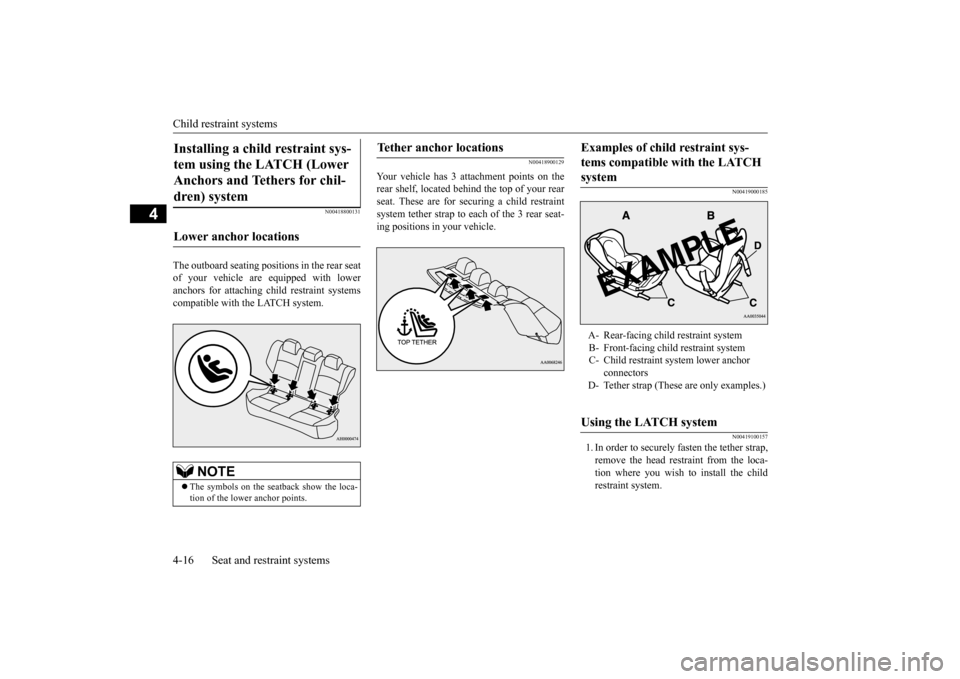
Child
restraint
systems
4-16
Seat and restraint systems
4
N0041880
0131
The
outboard
seating
positions
in the
rear
seat
of
your
vehicle
are
equipped
with
lower
anchors
for
attaching
child
restraint
systems
compatible with the LA
TCH system.
N0041890
0129
Your
vehicle
has
3 attachment
points
on
the
rear
shelf,
located
behind
the
top
of your
rear
seat.
These
are
for
securing
a child
restraint
system
tether
strap
to each
of
the
3 rear
seat-
ing
positions
in your
vehicle.
N0041900
0185
N0041910
0157
1.In order
to securely
fasten
the
tether
strap,
remove
the
head
restraint
from
the
loca-
tion
where
you
wish
to
install
the
child
restraint system.
Installing a child r
estraint sys-
tem using the LA
TCH (Lower
Anchors and
Tethers for chil-
dr
en) system
Lower anchor locations
NOTE
The
symbols
on
the
seatback
show
the
loca-
tion
of the
low
er anchor
points.
Tether anchor locations
Examples of child r
estraint sys-
tems compatible with the LA
TCH
system A-
Rear
-facing
child
restraint
system
B-
Front-facing child restraint system
C-
Child restraint system lower anchor connectors
D-
Tether
strap
(These
are
only
examples.)
Using the LA
TCH system